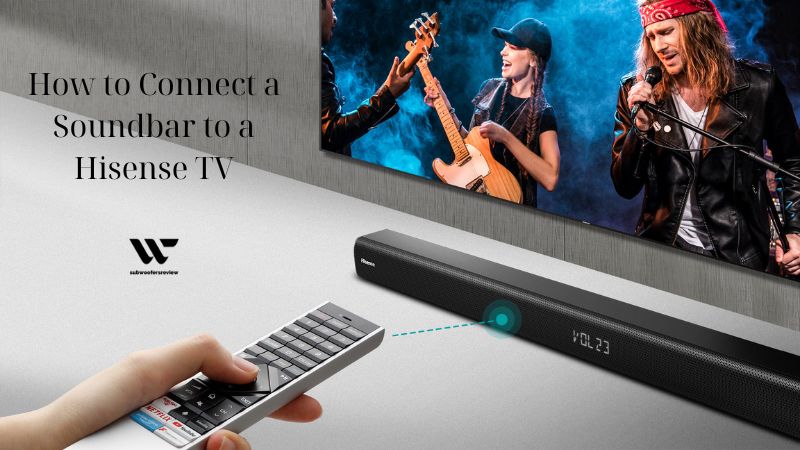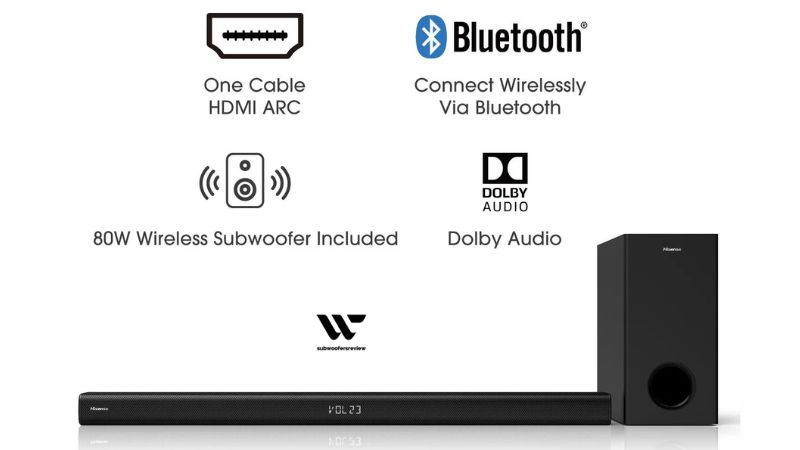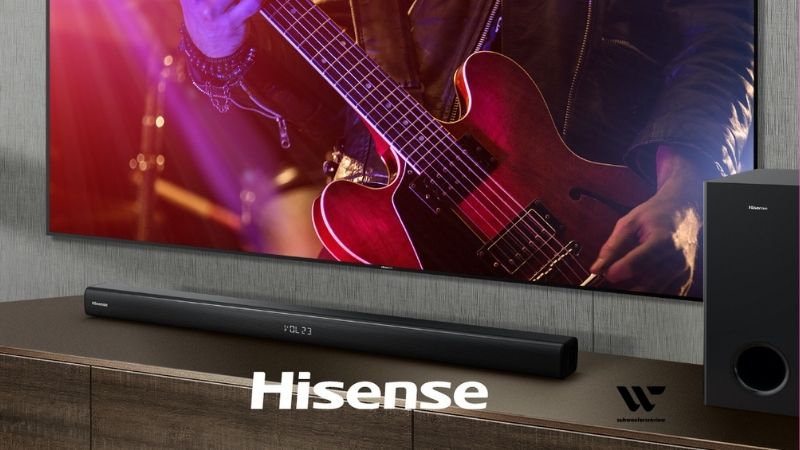Introducing the world of audio excellence! In this blog, we will explore the fascinating realm of soundbars and subwoofers, uncovering the secrets of achieving a truly immersive audio experience. Whether you’re a music lover, a movie enthusiast, or simply someone who appreciates crystal-clear sound quality, this guide is for you. Join subwoofersreview as we dive into how to connect Hisense soundbar to subwoofer, unraveling the mysteries that lie within. Get ready to elevate your audio game to new heights!
How to Connect Hisense Soundbar to Subwoofer
Make sure the soundbar and subwoofer are plugged in and powered on before beginning.
Option 1: Wired connection
Find the ports: The correct ports for wired connections are located on the rear of the Hisense soundbar and subwoofer. The ports are commonly marked “SUB IN” on the subwoofer and “SUB OUT” on the soundbar.
Use the proper cable: To connect the soundbar to the subwoofer, you’ll need an audio cable. An RCA cable with two connectors—typically red and white—is the most popular type of cable used for this purpose.
Connecting the cable: Insert one end of the RCA cable into the soundbar’s “SUB OUT” port. Ensure that it is attached safely. The other end should then be plugged into the subwoofer’s “SUB IN” connector.
Make sure the wire is securely fastened at both ends and that it is not twisted or kinked in any way.
Adjust settings: To enable the subwoofer output on some soundbars, you might need to open the settings menu. For details on how to do this, consult the user manual for your soundbar. If your subwoofer has controls, you might also need to change the settings on it.
Connectivity check: Verify that the subwoofer is functioning properly by playing some tones or test audio through your soundbar. A boost in bass will be audible.
Option 2: Wireless connection (Bluetooth)
Bluetooth wireless connectivity is supported by a few Hisense soundbars and subwoofers. When connecting them, do the following if your model has this capability:
Subwoofer pairing requires that you activate pairing mode on the subwoofer. Typically, to do this, hold down a special button on the subwoofer for a short period of time until an LED light on the speaker starts to flash, signaling that it is ready for pairing.
On your Hisense soundbar, use the remote control or control panel to enter the Bluetooth menu. Find Bluetooth devices by choosing this option.
Subwoofer pairing: From the list of accessible devices on the soundbar’s screen, choose the subwoofer when the soundbar detects the subwoofer in pairing mode.
Successful pairing is indicated by the subwoofer’s LED indicator light ceasing to flash, which means that the pair has been successful.
Connectivity check: Check that the subwoofer is wirelessly connected by playing music through your soundbar. Enhancement of the bass should be felt.
For thorough instructions and troubleshooting advice pertaining to your Hisense soundbar and subwoofer models, please refer to the user manual of those particular products since steps may differ.

How to Connect a Soundbar to a Hisense TV
The optimum option for using a Hisense TV’s soundbar is a wired connection. Yes, provided you plug in a cable to link your Hisense TV and audio system. You’ll enjoy your device’s highest-quality audio output. The soundbar can be connected to a Hisense TV using a variety of cables.
The best HDMI cables to use are HDMI ARC (Audio Return Channel) or HDMI EARC (Enhanced Audio Return Channel) files. You will find lines of HDMI cables. However, you can also use an optical connection (optical digital audio) to link the soundbar to a Hisense TV.
Why TV Sounds Better than the Soundbar?
Even with high-end soundbars, it’s frequently the case that they don’t perform as well as the TV to which they’re connected. The TV speakers operating properly and the soundbar not producing any sound are frequent causes of this.
This might happen while you’re using a set-top box, like a Sky or Freeview box, to watch television. There are instances when you might need a direct connection, even if your set-top box is linked to your TV and your TV is connected to your soundbar. When you utilize a set-top box that isn’t directly connected to the soundbar, this may occur.
You might need to use a digital optical cable (red and white connectors on later versions) or an RCA cable (red and white connectors on older devices) to connect directly to your soundbar depending on the age of the box.
As these cables deliver the picture, you must still need a Scart or HDMI cable to connect to your TV. To confirm that the sound is emanating from the soundbar rather than the TV, you’ll also need to access the sound settings on your set-top box. Return to the 3.5mm auxiliary port or optical audio connector that you want to utilize with the soundbar.
Hisense HS218 2.1ch Sound Bar with Wireless Subwoofer

The Hisense HS218 is a soundbar that is simple to install and connect to your TV. It is ideal for TVs 32 inches and larger and enhances the sound quality of your TV. You will be able to hear and feel everything in your enjoyment thanks to the wireless subwoofer.
Bluetooth is a feature of HS218 that makes it simple to connect wirelessly to smart devices. Use your laptop, tablet, or smartphone to listen to music.
The Hisense HS218 can connect wirelessly through Bluetooth and HDMI (ARC) to your TV, and you may use a single remote control to operate both devices. Better TV sound will be yours in a matter of minutes.
Hisense’s HS218 Soundbar can connect to any Roku TV via an HDMI (ARC) port because it is Roku TV Ready and is hence fully compatible. In order to simplify setup and improve navigation, you can even use the Roku TV remote to operate both the TV and speaker.
Included are the Hisense 218 Sound Bar, HDMI cable, optical cable, and wall mounting kit to guarantee that you have everything you need to start enjoying Hisense audio right away.
Conclusion
In conclusion, connecting a Hisense soundbar to a subwoofer is a straightforward process that greatly enhances the audio experience. By following the step-by-step instructions provided in this guide, users can easily enjoy the immersive and powerful sound that a subwoofer adds to their home entertainment setup.
Whether it’s for watching movies, playing games, or listening to music, the combination of a Hisense soundbar and a subwoofer ensures audio excellence and an enhanced overall viewing experience. So why wait? Start connecting your Hisense soundbar to a subwoofer today and enjoy the ultimate audio quality.

